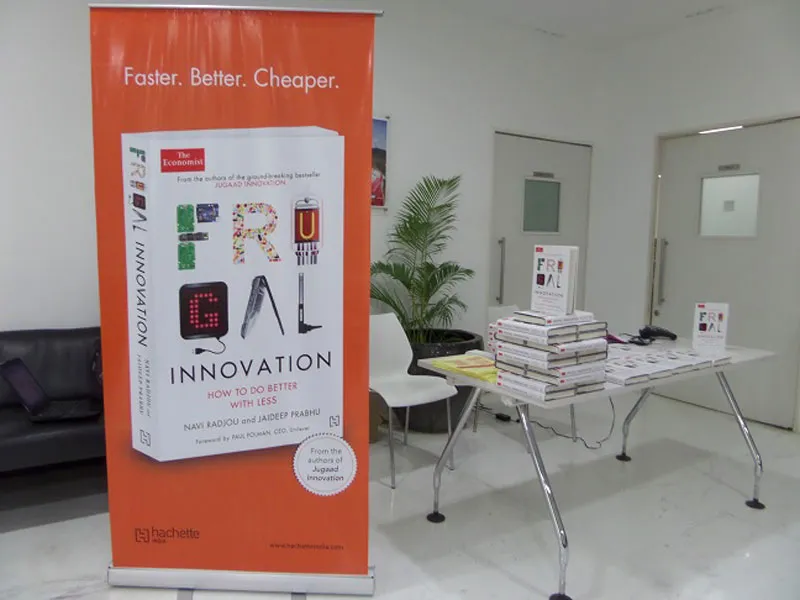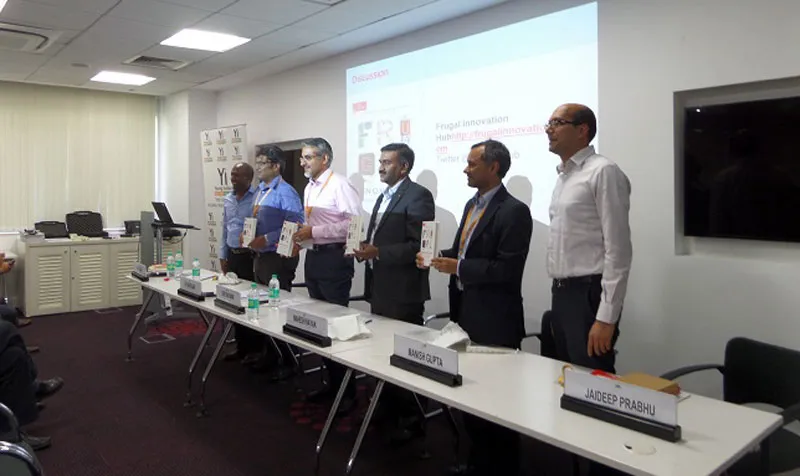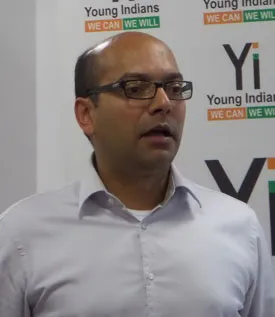Innovation 3.0: Indian creativity + Western business scale = global impact
Indians are known to have improvisation and creativity in their genes – and combined with the Western business scale of MNCs, the stage is ripe for a new wave of global collaborative innovation.
This was a key message delivered during the Bangalore launch of the book ‘Frugal Innovation’ by the authors, Navi Radjou and Jaideep Prabhu (see my book review). The launch was followed by a high-powered panel with industry leaders from SAP Labs, Mahindra Reva, GE, Xerox and CII. SAP Labs had also hosted the launch of the authors’ earlier book, ‘Jugaad Innovation,’ three years ago.

Navi Radjou is an innovation and leadership advisor based in Silicon Valley; Jaideep Prabhu is Director of the Centre for India & Global Business at Judge Business School, Cambridge. The co-authors offered three important lessons for Indian entrepreneurs, industry, educators and government for succeeding in 21st century innovation.
1. Seek global markets, ideas and partners in innovation
MittiCool, Godrej ChotuKool, Tata Nano, Narayana Hrudayalaya and the Indian IT/BPO services industry are good examples of frugal innovation in India, well documented in the authors' earlier book ‘Jugaad Innovation’ (see my book review and author interview).
‘Frugal Innovation 1.0’ also emerged in China and Africa, such as Kenya’s m-Pesa (mobile money) and m-Kopa (installed payment system for solar energy). India’s innovation capacity was showcased more recently by the Mangalayan Mars mission as well, completed at one tenth the cost and one third the time of NASA initiatives.
The next wave, ‘Frugal Innovation 2.0,’ is being powered by Western entrepreneurs and industrial giants. The frugality demand for value and values in innovation is also gathering steam in the West in recent years, reflected in the rise of ‘sharing economy’ startups like AirBnB, Uber and BlaBlaCar, and the call by citizens and regulators for companies to be socially and environmentally responsible. Green approaches by Western companies like Unilever are not just CSR but a core corporate strategy. Many youth are also expressing preference to work in socially responsible companies.

‘Frugal Innovation 3.0’ will consist of a more intense combining of forces between Indian innovators and global business giants from the West, according to Radjou and Prabhu. “India with the West, unlike China versus the West, is the way ahead for India,” advised Radjou.
2. Focus on simplicity and sustainability
The ‘Make in India’ initiative focuses on making innovative products in India that are of good quality while also being affordable by the masses. “Make in India should also address simplicity and sustainability,” added Radjou.
Customers want simple interfaces, simple products and simple services; they do not want bloatware. “China is realising that the circular economy is key to its long term success,” added Radjou; there is increasing awareness that rapid growth accompanied by pollution is unsustainable, and more efforts must be taken to reduce, reuse and upcycle.
3. Indian education should focus on ‘triathletes’

To succeed in the next generation of global innovation, Indian students need to become triathletes, advised Radjou. They need three core skillsets: creativity, empathy and logic. India needs well-rounded professionals with skills in design, social entrepreneurship, engineering and management. Unfortunately, Indian education operates in rigid silos with too few holistic inter-disciplinary flows.
The authors explained how these recommendations were backed by trends in the maker movement, sharing economy, circular economy and digital media in the West and Asia. The rise of the maker movement of tinkerers and creators is leading to more designated spaces like TechShops and FabLabs for home-based innovations to be showcased and shared by a larger community.
“My student created the Raspberry Pi, and the Italian

Arduino is even smaller and cheaper,” said Prabhu. Other frugal maker examples cited were CellScope (ear examination device attachable to a smartphone), Qarnot Computing (‘smart radiators’ to share computing power) and CompteNickel (pre-paid debit cards for the under-banked in France).
Western companies are now taking principles of frugal innovation to a much higher scale and scope than Indian companies. These include the Renault Logan (Europe’s cheapest car), Novartis (container-based drug manufacturing), BASF (mobile production units), and Pepsico (Global Value Innovation Centre in Gurgaon).
Small foundries in Coimbatore are performing industrial symbiosis (eg. sludge from steel plants being passed on to cement companies), but the Kalundborg Eco-industrial Park in Denmark is doing this on a much bigger scale.
With concerted efforts and ecosystem coordination, India is well poised to reclaim its frugal innovation credentials and also take them to a much higher plane for the whole world’s benefit, the authors concluded.







